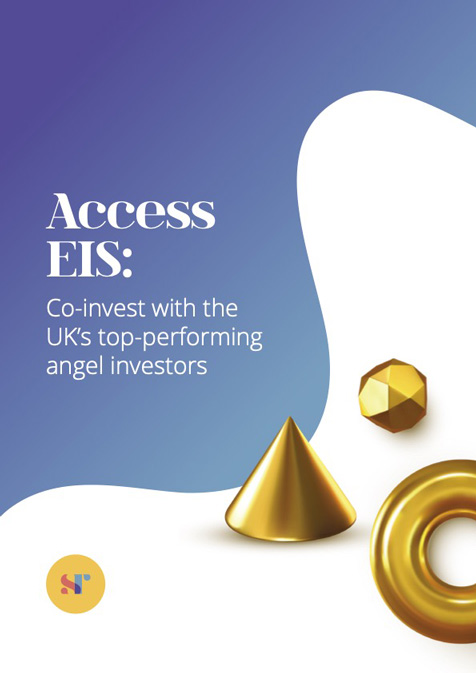We believe startups should always be considered by investors looking to build a well-balanced portfolio. This is because they show limited correlation to other asset classes and can provide good returns when investing is done smartly. In the UK we’re lucky because startup investing also brings very attractive tax benefits that have been put in place to encourage investment in higher risk early-stage businesses that drive much of the UK’s economic growth and job creation.
However, it’s not always clear how to go about investing in startups. In this article I want to look a bit more closely at investing in SEIS rounds versus EIS rounds.
How do EIS and SEIS differ?
EIS and SEIS both offer a way for investors to reduce their tax bill, but there are key differences between the two schemes. SEIS is designed for very early startups doing their first funding round and offers a higher level of tax relief for investors. SEIS tax relief can reduce an investor's tax bill by up to 50% of the amount invested, up to a maximum investment of £100,000. On the other hand, EIS tax relief is available for slightly later-stage startups and provides investors with a 30% reduction in tax on investments up to £1 million.
SEIS stands for Seed Enterprise Investment Scheme and the word “seed” is key here. You are investing in startups raising their first £150k (changing to £250k based on the latest budget). At this time in their journey they most likely will have no traction or track record and your investment is really in the team and the idea. This makes it higher risk and it’s why it offers a larger amount of tax relief.

EIS investments in the same company are available after this amount has been raised and upto when the firm has raised a cumulative £12m (after which they are no longer eligible to raise via EIS unless they are a knowledge-intensive company). This means EIS can go into startups at a much later stage of development and risk. Therefore, the difference in risk profile of SEIS and EIS is quite stark.
Risk
Typically, when we consider risk in finance, we look at variance of returns and the average expected return. A riskier investment will have a high variance around a high return and therefore there is a wide range of potential outcomes - you could make a lot of money but also lose all your money.
We can apply this to startup investing to some extent, although the power law for early stage deals does throw the analysis out of whack since there is no defined variance - the presence of absolute blockbuster deals breaks typical sampling models. If you want to understand this better, go check out our white paper. Nonetheless, if we do apply some upper bounds to the potential returns by looking at historical data we can try some sampling.
I haven’t had the resources to run all the SEIS deals, and indeed it can be difficult to identify rounds that are part SEIS and part EIS, but we can take a sampling of 156 rounds under £150k from 2011-2014 and see how the valuations have performed. Then we can compare this to all rounds above that size.

Returns on a large SEIS cohort can be excellent, around 35% on average, but the variation is massive and the failure rate is about 40% higher than later rounds. The exit rate also varies by a large margin – 80% more companies go on to exit when raising EIS when compared to the SEIS rounds.
This makes sense, as EIS companies will have more traction and are now lower risk. Of course, there are big potential returns for the very first round of a company that go with the higher risk. When you look at the SEIS sample it is brought up by pre-seed investments in companies when they were valued at around £1m and went on to be Unicorns. Deliveroo is an example, having raised £115k at £1.5m in 2013 and then underwent a £1bn IPO (with no capital gains thanks to S/EIS relief). This is the power law at work - there will be massive outliers.
However, because of the greater variance and failure rate, you’re likely to lose money (even with tax relief) unless you invest in 75+ startups. It is quite hard to find that many SEIS rounds to participate in (see final paragraph on access). Returns on EIS are lower than SEIS when you index them, but with less variation and it’s easier to build a portfolio of 50+ startups. We’ve covered the EIS landscape in detail in our first white paper.
Access
There is an important factor to consider when going for SEIS rounds and it has to do with deal access. The first round of a company often seeks out some key angel investors to assist with the very early growth decisions and network introductions.
Although the best angel investors will be drawn to strong teams and ideas, there is definitely additional value to them from the SEIS tax relief. Therefore that tax relief will often be reserved for high value investors or even friends and family who are taking a relatively big risk supporting the fledgling company. It’s therefore great for those type of investors to get the SEIS and it helps the company close their first round quickly. It is not always available to more generic startup investors or even funds, and I’m not sure it should be.
A good startup with SEIS available will close very quickly with super angel investors. The ones that are not able to close it may have some red flags and should probably be avoided by most investors.
In summary, there are some amazing deals to be had with SEIS and, if you know what you are doing and know the right people, you can get into them. However, you must also exercise caution because of the very high failure rate and low exit rate. Many will say the same for EIS rounds, and although it is still in the high risk territory, they have a lot more exits and there are more ways to mitigate that risk by being able to access better quality deals and by building a larger, more diversified portfolio.

What is Access EIS?
Read our fund brochure for everything you need to know about the Access EIS Fund, from the specifics of our innovative co-investment model to our fees, and how to invest.
Register to learn
more about our data,
fund and venture capital

